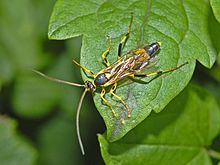| Amblyteles armatorius | |
|---|---|

| |
| Dorsal view | |

| |
| Lateral view | |
| Scientific classification | |
| Kingdom: | Animalia |
| Phylum: | Arthropoda |
| Class: | Insecta |
| Order: | Hymenoptera |
| Suborder: | Apocrita |
| Superfamily: | Ichneumonoidea |
| Family: | Ichneumonidae |
| Subfamily: | Ichneumoninae |
| Genus: | Amblyteles |
| Species: | A. armatorius |
| Binomial name | |
| Amblyteles armatorius (Förster, 1771) | |
| Synonyms | |
| |
Amblyteles armatorius is a species of parasitic wasp in the family Ichneumonidae first described by Johann Reinhold Forster in 1771.
Description
Amblyteles armatorius can reach a length of 12–16 mm, excluding antennae, which reach about 9 millimetres (0.35 in). The head and thorax of this large wasp are black, except the yellow scutellum. The abdomen is yellow and more oval in the females, with broad black bands. Legs are yellow, except the hind legs, that are black and yellow. This species lacks a sting, so the characteristic markings of many aculeate wasps represent a protective mimicry. The female has a very short ovipositor that doesn't protrude from the abdomen.
Adults can be usually found in summer on flowers, especially Apiaceae species, feeding on nectar and pollen. The adults overwinter. The females of this parasitic wasp lay their eggs into the caterpillars of moths. When they hatch larvae feed on their hosts, mainly Noctuidae and Notodontidae, but also some Geometridae, Erebidae, Saturniidae and Lasiocampidae (Calliteara pudibunda, Odontopera bidentata, Macrothylacia rubi and Saturnia pavonia).
Distribution and habitat
This species is a Palearctic species that is present in most of Europe, in the Near East, and in the Oriental realm. These wasps usually occur in hedgerows, meadows and spruce forest edges.
References
- Tischbein, P.F.L. (1868) Hymenopterologische Beitrage., Stettiner Entomologische Zeitung. 29:248-258.
- Stephens, J.F. (1835) Illustrations of British Entomology. Mandibulata. Vol. VII., Baldwin & Cradock, London. 306 pp.
- Olivier, M. (1792) Ichneumon., Encyclopedie methodique, Histoire naturelle. Insectes. 7:133-224.
- Gmelin, J.F. (1790) Caroli a Linne Systema Naturae (Ed. XIII). Tom I., G.E. Beer. Lipsiae. 2225-3020. (Ichneumon: 2674-2722).
- Villers, C. de (1789) Caroli Linnaei entomologia, Faunae Suecicae descriptionibus. Tomus tertius., Lugduni. 657 pp. (Ichneumon on pp. 134-218)
- ^ Fabricius, J.C. (1775) Systema Entomologiae, sistens Insectorum classes, ordines, genera, species., Flensburgi et Lipsae. 832 pp.
- ^ Tereshkin, Alexander M. (2009). "Illustrated key to the tribes of subfamilia Ichneumoninae and genera of the tribe Platylabini of world fauna (Hymenoptera, Ichneumonidae)". Linzer biologische Beiträge: 1317–1608.
- Nature Spot
- "Insectoid.info". Archived from the original on 2017-03-12. Retrieved 2014-07-10.
- ^ "Commanster". Archived from the original on 2013-04-20. Retrieved 2014-07-10.
- Kolarov, Janko; Ghahari, Hassan (2005). "A catalogue of Ichneumonidae (Hymenoptera) from Iran". Linzer biologische Beiträge. 37 (1): 503–532. Retrieved 2022-07-01.
- Fauna Europaea
| Taxon identifiers | |
|---|---|
| Amblyteles armatorius | |
This Ichneumonidae-related article is a stub. You can help Misplaced Pages by expanding it. |